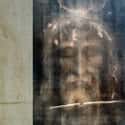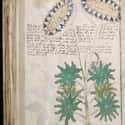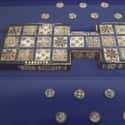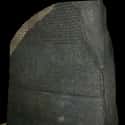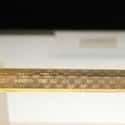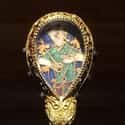-
(#15) Shroud of Turin
Though its authenticity is a matter of fierce debate (and has been since it first emerged in the mid-14th century), the Shroud of Turin remains a powerful religious icon to many Christians the world over. Believed by some to be the burial shroud of Jesus Christ, the cloth has been studied extensively by scientists and religious scholars alike.
Today, the shroud is closely guarded behind bulletproof glass and seldom seen by the public. However, following the global turmoil of the COVID-19 pandemic, it was made available to view online in April 2020.
-
(#8) The Voynich Manuscript (c. 15th Century AD)
Sometimes called "the world's most mysterious book," this 15th century codex is written in an unknown script by an unknown author. It gets its name from Wilfrid Voynich, who first came across it in 1912, but the book has popped up here and there over the centuries. A translation of the text, and the purpose of the book itself, eludes investigators to this day.
The manuscript contains "lively" illustrations that appear to encompass a number of scientific topics, from botanical species to astronomical charts to female biology. The origin of the manuscript remains a matter of debate, with some claiming the thing is just a hoax, and others saying it's the work of aliens.
-
(#10) British Museum Royal Game of Ur (c. 2600-2400 BC)
Popular throughout the Mediterranean and the Middle East thousands of years ago, the Royal Game of Ur was a popular pastime for ancient peoples.
As Irving Finkel, the assistant keeper at London's British Museum in the Department of the Middle East, explains, "There were no entertainments for such a huge period of human existence. In that environment, games had a fantastically strong hold. They reigned supreme."
Time sums it up even better: "For centuries, even millenniums, the Royal Game of Ur served as the PlayStation of its day."
-
(#1) Rosetta Stone
- Relief
This giant slab of basalt is where the Rosetta Stone language-learning program gets its name. Discovered by Napoleon Bonaparte's army in 1799, the slab contains a decree from King Ptolemy V (r. 204-181 BC) written in three different languages: Egyptian hieroglyphic, Egyptian Demotic (the "language of the people"), and ancient Greek (the language of Egypt's Greco-Macedonian rulers).
As the British Museum explains:
The importance of [the Rosetta Stone] to Egyptology is immense. When it was discovered, nobody knew how to read ancient Egyptian hieroglyphs. Because the inscriptions say the same thing in three different scripts, and scholars could still read Ancient Greek, the Rosetta Stone became a valuable key to deciphering the hieroglyphs.
-
(#6) Sword Of Goujian (c. 771-403 BC)
Despite being more than 2,500 years old, this Chinese dagger still retains a cutting edge. It was discovered in a tomb in Hubei, China, in 1965, and is believed to date back to the era between 771 and 403 BC. Forged from copper and tin, the blade also contains blue crystals and turquoise.
The Metropolitan Museum of Art notes that the eight characters engraved on the blade are an ancient writing called "bird-worm seal script," which reads, "King of Yue... made this sword for [his] personal use."
-
(#9) The Alfred Jewel (c. Ninth Century AD)
Discovered in a field in Somerset, England, in 1693, this royal relic dates to the reign of King Alfred the Great (871-899 AD) and bears the inscription "AELFRED MEC HEHT GEWYRCAN," or "Alfred ordered me to be made."
According to the Ashmolean Museum, the jewel was originally part of an aestel, or pointer, a device used to follow text in manuscripts. A "significant" piece of Anglo-Saxon goldsmithing, the aestel was crafted around a slice of rock crystal.
New Random Displays Display All By Ranking
About This Tool
While ancient times happened so long ago, some things never change. Over the years, archaeologists from all over the world have devoted themselves to excavating and exploring the history of human civilization. They have unearthed many valuable ancient cultural artifacts in a wide range, including tools, pottery, metal objects, personal items, etc. Cultural relics are relics and relics that reflect the material and spiritual culture of a nation.
The random tool shows 15 amazing artifacts from ancient times that reflect social development and social life from different aspects, and they are physical materials for studying the history of the ancient world.
Our data comes from Ranker, If you want to participate in the ranking of items displayed on this page, please click here.











